Optimizing Tomato Yield and Quality in Greenhouse Cultivation Through Fertilization and Soil Management
Abstract
1. Introduction
2. Materials and Methods
2.1. Experimental Site and Growth Conditions
2.2. Preparation of Biological Material
2.3. Fertilization Protocol
- Variant 1: Albit (0.01%) + Turboroot (0.5%)
- Variant 2: Biochar (10 g/plant) + Wood Vinegar (0.5%) + Cropmax (0.25%)
- Variant 3: Nutriplant 20:20:20 (0.015%) + Resid (2 g/plant)
- Variant 4: Orgevit (10 g/plant) + Kerafol (0.25%)
- Variant 5: Control (untreated)
2.4. Biometric and Yield Assessments
2.5. Quality Analysis of Tomato Fruit
2.5.1. Fruit Material
2.5.2. Carotenoid and Lycopene Content
2.5.3. Total Dry Matter Content (TDM %)
2.5.4. Total Soluble Solids (TSS)
2.6. Pest and Disease Management
- n denotes the total number of analyzed plants exhibiting signs of infestation, and
- Nt indicates the overall count of all plants subjected to examination.
- i denotes the assigned score representing the percentage of the plant surface area affected by the infestation, categorized as follows:
- o
- Score 0: 0% affected surface;
- o
- Score 1: 1–3% affected surface;
- o
- Score 2: 4–10% affected surface;
- o
- Score 3: 11–25% affected surface;
- o
- Score 4: 26–50% affected surface;
- o
- Score 5: 51–75% affected surface;
- o
- Score 6: 76–100% affected surface.
- f is the total number of plants evaluated within each specific score category, and
- n is again the total number of analyzed plants that show signs of infestation.
2.7. Soil Compaction Assessment
2.8. Statistical Analysis
3. Results
3.1. Determination of Biometric Indicators
3.1.1. Plant Height
3.1.2. Lateral Shoot Development
3.1.3. Collar Stem Diameter
3.1.4. Flower Number
3.2. Anthocyanin and Chlorophyll Pigment Content
3.2.1. Anthocyanin Content Index
3.2.2. Chlorophyll Content Index
3.3. Assessment of Yield Metrics
3.3.1. Average Fruit Weight
3.3.2. Fruit Width
3.3.3. Fruit Height
3.3.4. Number of Fruits per Plant
3.3.5. Total Yield per Plant
3.4. Analysis of Lycopene and Carotenoid Content in Tomato Fruits
3.4.1. Lycopene Content
3.4.2. Carotenoid Content
3.5. Determination of Total Dry Matter and Total Soluble Solids Contents in Tomato Fruits
3.5.1. Total Dry Matter Content
3.5.2. Soluble Solids Content
3.6. Management of Diseases and Pests
3.7. Results Regarding Compaction Levels in Different Types of Soil Management for Protected Spaces
4. Discussion
4.1. Implications for Greenhouse Production, Economic Viability, and Environmental Adaptability
4.2. Recommendation and Long-Term Perspectives
4.3. Limitations and Future Research Directions
5. Conclusions
Author Contributions
Funding
Data Availability Statement
Acknowledgments
Conflicts of Interest
References
- Murariu, O.C.; Brezeanu, C.; Jităreanu, C.D.; Robu, T.; Irimia, L.M.; Trofin, A.E.; Popa, L.-D.; Stoleru, V.; Murariu, F.; Brezeanu, P.M. Functional Quality of Improved Tomato Genotypes Grown in Open Field and in Plastic Tunnel under Organic Farming. Agriculture 2021, 11, 609. [Google Scholar] [CrossRef]
- Sattar, S.; Iqbal, A.; Parveen, A.; Fatima, E.; Samdani, A.; Fatima, H.; Shahzad, M. Tomatoes Unveiled: A Comprehensive Exploration from Cultivation to Culinary and Nutritional Significance. Qeios 2024, CC-BY4.0, 1–9. [Google Scholar] [CrossRef]
- Umeohia, U.E.; Olapade, A.A. Quality Attributes, Physiology, and Postharvest Technologies of Tomatoes (Lycopersicum esculentum)—A Review. Am. J. Food Sci. Technol. 2024, 12, 42–64. [Google Scholar] [CrossRef]
- Ofori, P.A.; Owusu-Nketia, S.; Opoku-Agyemang, F.; Agbleke, D.; Amissah, J.N. Greenhouse Tomato Production for Sustainable Food and Nutrition Security in the Tropics. In Tomato-From Cultivation to Processing Technology; IntechOpen: London, UK, 2022; ISBN 1-80356-459-8. [Google Scholar]
- Lastochkina, O.; Aliniaeifard, S.; SeifiKalhor, M.; Bosacchi, M.; Maslennikova, D.; Lubyanova, A. Novel Approaches for Sustainable Horticultural Crop Production: Advances and Prospects. Horticulturae 2022, 8, 910. [Google Scholar] [CrossRef]
- Wu, W.; Lin, Z.; Zhu, X.; Li, G.; Zhang, W.; Chen, Y.; Ren, L.; Luo, S.; Lin, H.; Zhou, H. Improved Tomato Yield and Quality by Altering Soil Physicochemical Properties and Nitrification Processes in the Combined Use of Organic-Inorganic Fertilizers. Eur. J. Soil Biol. 2022, 109, 103384. [Google Scholar] [CrossRef]
- da Silva Martins, J.V.; Pereira, E.D.; de Araújo, N.O.; de Araújo, F.F.; da Silva, T.I.; da Silva, D.J.H.; de Melo Silva, S.; Ribeiro, W.S.; Dias, T.J. A Combined Soil and Water Management Strategy to Improve the Nutrition and Marketability of Tomato Variety ‘Heinz 9553’. J. Plant Growth Regul. 2024, 43, 500–515. [Google Scholar] [CrossRef]
- Hartmann, M.; Six, J. Soil Structure and Microbiome Functions in Agroecosystems. Nat. Rev. Earth Environ. 2023, 4, 4–18. [Google Scholar] [CrossRef]
- Bhaduri, D.; Sihi, D.; Bhowmik, A.; Verma, B.C.; Munda, S.; Dari, B. A Review on Effective Soil Health Bio-Indicators for Ecosystem Restoration and Sustainability. Front. Microbiol. 2022, 13, 938481. [Google Scholar] [CrossRef] [PubMed]
- Okorie, B.O.; Niraj, Y. Effects of Different Tillage Practices on Soil Fertility Properties: A Review. Int. J. Agric. Environ. Res. 2022, 8, 176–193. [Google Scholar] [CrossRef]
- Angon, P.B.; Anjum, N.; Akter, M.M.; KC, S.; Suma, R.P.; Jannat, S. An Overview of the Impact of Tillage and Cropping Systems on Soil Health in Agricultural Practices. Adv. Agric. 2023, 2023, 8861216. [Google Scholar] [CrossRef]
- Gu, Y.; Liu, Y.; Li, J.; Cao, M.; Wang, Z.; Li, J.; Meng, D.; Cao, P.; Duan, S.; Zhang, M. Mechanism of Intermittent Deep Tillage and Different Depths Improving Crop Growth from the Perspective of Rhizosphere Soil Nutrients, Root System Architectures, Bacterial Communities, and Functional Profiles. Front. Microbiol. 2022, 12, 759374. [Google Scholar] [CrossRef]
- Blanco, H.; Lal, R. Tillage Systems. In Soil Conservation and Management; Springer: Berlin/Heidelberg, Germany, 2023; pp. 127–157. [Google Scholar]
- Zhu, S.; Gao, T.; Liu, Z.; Ning, T. Rotary and Subsoiling Tillage Rotations Influence Soil Carbon and Nitrogen Sequestration and Crop Yield. Plant Soil Environ. 2022, 68, 89–97. [Google Scholar] [CrossRef]
- Barłóg, P.; Grzebisz, W.; Łukowiak, R. Fertilizers and Fertilization Strategies Mitigating Soil Factors Constraining Efficiency of Nitrogen in Plant Production. Plants 2022, 11, 1855. [Google Scholar] [CrossRef] [PubMed]
- Fan, H.; Zhang, Y.; Li, J.; Jiang, J.; Waheed, A.; Wang, S.; Rasheed, S.M.; Zhang, L.; Zhang, R. Effects of Organic Fertilizer Supply on Soil Properties, Tomato Yield, and Fruit Quality: A Global Meta-Analysis. Sustainability 2023, 15, 2556. [Google Scholar] [CrossRef]
- Ou, X.; Liu, D.; Liu, A.; Liu, H.; Chen, R.; Zhang, Y. Effects of Nutrient Solution Management Modes on Fruit Production and Quality of Tomatoes Grown in Extremely Root Restriction. Sci. Hortic. 2023, 321, 112366. [Google Scholar] [CrossRef]
- Francis, B.; Aravindakumar, C.; Brewer, P.B.; Simon, S. Plant Nutrient Stress Adaptation: A Prospect for Fertilizer Limited Agriculture. Environ. Exp. Bot. 2023, 213, 105431. [Google Scholar] [CrossRef]
- Howe, J.A.; McDonald, M.D.; Burke, J.; Robertson, I.; Coker, H.; Gentry, T.J.; Lewis, K.L. Influence of Fertilizer and Manure Inputs on Soil Health: A Review. Soil Secur. 2024, 16, 100155. [Google Scholar] [CrossRef]
- Simkin, A.J.; Kapoor, L.; Doss, C.G.P.; Hofmann, T.A.; Lawson, T.; Ramamoorthy, S. The Role of Photosynthesis Related Pigments in Light Harvesting, Photoprotection and Enhancement of Photosynthetic Yield in Planta. Photosynth. Res. 2022, 152, 23–42. [Google Scholar] [CrossRef]
- Ebrahimi, P.; Shokramraji, Z.; Tavakkoli, S.; Mihaylova, D.; Lante, A. Chlorophylls as Natural Bioactive Compounds Existing in Food By-Products: A Critical Review. Plants 2023, 12, 1533. [Google Scholar] [CrossRef]
- Li, Z.; Ahammed, G.J. Plant Stress Response and Adaptation via Anthocyanins: A Review. Plant Stress 2023, 10, 100230. [Google Scholar] [CrossRef]
- Tufail, T.; Bader Ul Ain, H.; Noreen, S.; Ikram, A.; Arshad, M.T.; Abdullahi, M.A. Nutritional Benefits of Lycopene and Beta-Carotene: A Comprehensive Overview. Food Sci. Nutr. 2024, 12, 8715–8741. [Google Scholar] [CrossRef]
- Wang, C.; Li, M.; Duan, X.; Abu-Izneid, T.; Rauf, A.; Khan, Z.; Mitra, S.; Emran, T.B.; Aljohani, A.S.; Alhumaydhi, F.A. Phytochemical and Nutritional Profiling of Tomatoes; Impact of Processing on Bioavailability-a Comprehensive Review. Food Rev. Int. 2023, 39, 5986–6010. [Google Scholar] [CrossRef]
- Su, J.-Y.; Liu, C.-H.; Tampus, K.; Lin, Y.-C.; Huang, C.-H. Organic Amendment Types Influence Soil Properties, the Soil Bacterial Microbiome, and Tomato Growth. Agronomy 2022, 12, 1236. [Google Scholar] [CrossRef]
- Wu, Y.; Yan, S.; Fan, J.; Zhang, F.; Zhao, W.; Zheng, J.; Guo, J.; Xiang, Y.; Wu, L. Combined Effects of Irrigation Level and Fertilization Practice on Yield, Economic Benefit and Water-Nitrogen Use Efficiency of Drip-Irrigated Greenhouse Tomato. Agric. Water Manag. 2022, 262, 107401. [Google Scholar] [CrossRef]
- Xiang, Y.; Li, Y.; Luo, X.; Liu, Y.; Yue, X.; Yao, B.; Xue, J.; Zhang, L.; Fan, J.; Xu, X. Manure Properties, Soil Conditions and Managerial Factors Regulate Greenhouse Vegetable Yield with Organic Fertilizer Application across China. Front. Plant Sci. 2022, 13, 1009631. [Google Scholar] [CrossRef] [PubMed]
- Góngora, C.E.; Silva, M. do C. Sustainable Strategies for the Control of Crop Diseases and Pests to Reduce Pesticides. Agronomy 2024, 14, 2158. [Google Scholar] [CrossRef]
- Gonzalez Guzman, M.; Cellini, F.; Fotopoulos, V.; Balestrini, R.; Arbona, V. New Approaches to Improve Crop Tolerance to Biotic and Abiotic Stresses. Physiol. Plant. 2022, 174, e13547. [Google Scholar] [CrossRef]
- Chauhan, A.P.S.; Singh, D.; Sharma, O.P.; Kushwah, N.; Kumhare, A. Agronomic Practices for Enhancing Resilience in Crop Plants. Plant Science Archives 2023, 8, 1–3. [Google Scholar] [CrossRef]
- Horwitz, W.; Latimer, G. Official Methods of Analysis of AOAC International, 18th ed.; AOAC International: Rockville, MD, USA, 2005. [Google Scholar]
- Guimarães, R.M.L.; Ball, B.C.; Tormena, C.A. Improvements in the Visual Evaluation of Soil Structure. Soil Use Manag. 2011, 27, 395–403. [Google Scholar] [CrossRef]
- Kaur, S.; Tiwari, V.; Kumari, A.; Chaudhary, E.; Sharma, A.; Ali, U.; Garg, M. Protective and Defensive Role of Anthocyanins under Plant Abiotic and Biotic Stresses: An Emerging Application in Sustainable Agriculture. J. Biotechnol. 2023, 361, 12–29. [Google Scholar] [CrossRef]
- Nassour, R.; Ayash, A.; Al-Tameemi, K. Anthocyanin Pigments: Structure and Biological Importance. J. Chem. Pharm. Sci. 2020, 13, 45–57. [Google Scholar]
- Liu, C.; Liu, Y.; Lu, Y.; Liao, Y.; Nie, J.; Yuan, X.; Chen, F. Use of a Leaf Chlorophyll Content Index to Improve the Prediction of Above-Ground Biomass and Productivity. PeerJ 2019, 6, e6240. [Google Scholar] [CrossRef]
- Li, Y.; Liu, C.; Zhang, J.; Yang, H.; Xu, L.; Wang, Q.; Sack, L.; Wu, X.; Hou, J.; He, N. Variation in Leaf Chlorophyll Concentration from Tropical to Cold-Temperate Forests: Association with Gross Primary Productivity. Ecol. Indic. 2018, 85, 383–389. [Google Scholar] [CrossRef]
- Wu, C.; Niu, Z.; Tang, Q.; Huang, W.; Rivard, B.; Feng, J. Remote Estimation of Gross Primary Production in Wheat Using Chlorophyll-Related Vegetation Indices. Agric. For. Meteorol. 2009, 149, 1015–1021. [Google Scholar] [CrossRef]
- Enaru, B.; Drețcanu, G.; Pop, T.D.; Stǎnilǎ, A.; Diaconeasa, Z. Anthocyanins: Factors Affecting Their Stability and Degradation. Antioxidants 2021, 10, 1967. [Google Scholar] [CrossRef] [PubMed]
- Mannino, G.; Gentile, C.; Ertani, A.; Serio, G.; Bertea, C.M. Anthocyanins: Biosynthesis, Distribution, Ecological Role, and Use of Biostimulants to Increase Their Content in Plant Foods—A Review. Agriculture 2021, 11, 212. [Google Scholar] [CrossRef]
- Yang, L.; Wen, K.-S.; Ruan, X.; Zhao, Y.-X.; Wei, F.; Wang, Q. Response of Plant Secondary Metabolites to Environmental Factors. Molecules 2018, 23, 762. [Google Scholar] [CrossRef]
- Hossain, M.Z.; Bahar, M.M.; Sarkar, B.; Donne, S.W.; Ok, Y.S.; Palansooriya, K.N.; Kirkham, M.B.; Chowdhury, S.; Bolan, N. Biochar and Its Importance on Nutrient Dynamics in Soil and Plant. Biochar 2020, 2, 379–420. [Google Scholar] [CrossRef]
- Peiris, C.; Gunatilake, S.R.; Wewalwela, J.J.; Vithanage, M. Biochar for Sustainable Agriculture: Nutrient Dynamics, Soil Enzymes, and Crop Growth. In Biochar from Biomass and Waste; Elsevier: Amsterdam, The Netherlands, 2019; pp. 211–224. [Google Scholar] [CrossRef]
- Jin, H.; Li, M.; Duan, S.; Fu, M.; Dong, X.; Liu, B.; Feng, D.; Wang, J.; Wang, H.-B. Optimization of Light-Harvesting Pigment Improves Photosynthetic Efficiency. Plant Physiol. 2016, 172, 1720–1731. [Google Scholar] [CrossRef]
- Mohan, D.; Pittman Jr, C.U.; Steele, P.H. Pyrolysis of Wood/Biomass for Bio-Oil: A Critical Review. Energy Fuels 2006, 20, 848–889. [Google Scholar] [CrossRef]
- Abbas, T.; Rizwan, M.; Ali, S.; Adrees, M.; Mahmood, A.; Zia-ur-Rehman, M.; Ibrahim, M.; Arshad, M.; Qayyum, M.F. Biochar Application Increased the Growth and Yield and Reduced Cadmium in Drought Stressed Wheat Grown in an Aged Contaminated Soil. Ecotoxicol. Environ. Saf. 2018, 148, 825–833. [Google Scholar] [CrossRef]
- Apahidean, A.I.; Domocoș, D.; Çărbunar, M.; Bei, M.; Hoza, G.; Apahidean, A.S. Cultivar and Fertilization Influence on Production and Quality of Tomatoes Grown in Polyethylene Tunnels in Ecological System. Sci. Papers. Ser. B Hortic. 2019, 63, 307–314. [Google Scholar]
- Brezeanu, P.M.; Brezeanu, C.; Tremurici, A.A.; Ambăruş, S.; Bute, A. Effects of Organic Inputs Application on Yield and Qualitative Parameters of Tomatoes and Peppers. Sci. Papers. Ser. B Hortic. 2022, 66, 429–437. [Google Scholar]
- Lin, L.; De Pue, J.; Vivanco, A.K.M.; Van der Bolt, F.; Cornelis, W. Visual Assessment of Soil Structural Quality across Soil Textures and Compaction Levels–Part I: Examination of Intact Soil Cores. Geoderma 2022, 426, 116099. [Google Scholar] [CrossRef]
- De Vasconcelos, A.C.F.; Chaves, L.H.G. Biostimulants and Their Role in Improving Plant Growth under Abiotic Stresses. In Biostimulants in Plant Science; IntechOpen: London, UK, 2019; pp. 3–16. [Google Scholar] [CrossRef]
- Rouphael, Y.; Colla, G. Biostimulants in Agriculture. Front. Plant Sci. 2020, 11, 40. [Google Scholar] [CrossRef] [PubMed]
- Fahad, S.; Sonmez, O.; Saud, S.; Wang, D.; Wu, C.; Adnan, M.; Turan, V. Plant Growth Regulators for Climate-Smart Agriculture; CRC Press: Boca Raton, FL, USA, 2021; ISBN 1-00-040855-8. [Google Scholar]
- Zhang, X.; Guo, Q.; Xu, Y.; Li, P.; Chen, C.; Wu, S. Mechanical Testing of Tomato Plant Stem in Relation to Structural Composition. Agric. Res. 2016, 5, 236–245. [Google Scholar] [CrossRef]
- Calvo, P.; Nelson, L.; Kloepper, J.W. Agricultural Uses of Plant Biostimulants. Plant Soil 2014, 383, 3–41. [Google Scholar] [CrossRef]
- Bulgari, R.; Franzoni, G.; Ferrante, A. Biostimulants Application in Horticultural Crops under Abiotic Stress Conditions. Agronomy 2019, 9, 306. [Google Scholar] [CrossRef]
- Chen, L.; Liao, H. Engineering Crop Nutrient Efficiency for Sustainable Agriculture. J. Integr. Plant Biol. 2017, 59, 710–735. [Google Scholar] [CrossRef]
- Hasnain, M.; Chen, J.; Ahmed, N.; Memon, S.; Wang, L.; Wang, Y.; Wang, P. The Effects of Fertilizer Type and Application Time on Soil Properties, Plant Traits, Yield and Quality of Tomato. Sustainability 2020, 12, 9065. [Google Scholar] [CrossRef]
- Kleinhenz, V.; Katroschan, K.; Schutt, F.; Stutzel, H. Biomass Accumulation and Partitioning of Tomato under Protected Cultivation in the Humid Tropics. Eur. J. Hortic. Sci. 2006, 71, 173. [Google Scholar] [CrossRef]
- Ho, L.C. Tomato. In Photoassimilate Distribution Plants and Crops Source-Sink Relationships; Routledge: London, UK, 2017; pp. 709–778. ISBN 978-0-203-74353-9. [Google Scholar]
- Dewi, J. Redox Regulation of Shoot Branching and Dormancy in Plants. Ph.D. Thesis, The University of Western Australia, Perth, Australia, 2023. [Google Scholar] [CrossRef]
- Paponov, M.; Verheul, M.J.; Dobrev, P.I.; Paponov, I.A. Additive Effects of Light and Branching on Fruit Size and Chemical Fruit Quality of Greenhouse Tomatoes. Front. Plant Sci. 2023, 14, 1221163. [Google Scholar] [CrossRef]
- Shi, L.; Li, X.; Fu, Y.; Li, C. Environmental Stimuli and Phytohormones in Anthocyanin Biosynthesis: A Comprehensive Review. Int. J. Mol. Sci. 2023, 24, 16415. [Google Scholar] [CrossRef] [PubMed]
- Briat, J.-F.; Gojon, A.; Plassard, C.; Rouached, H.; Lemaire, G. Reappraisal of the Central Role of Soil Nutrient Availability in Nutrient Management in Light of Recent Advances in Plant Nutrition at Crop and Molecular Levels. Eur. J. Agron. 2020, 116, 126069. [Google Scholar] [CrossRef]
- Vogel, H.; Balseiro-Romero, M.; Kravchenko, A.; Otten, W.; Pot, V.; Schlüter, S.; Weller, U.; Baveye, P.C. A Holistic Perspective on Soil Architecture Is Needed as a Key to Soil Functions. Eur. J. Soil Sci. 2022, 73, e13152. [Google Scholar] [CrossRef]
- Banoo, A.; Hussain, S.; Hussain, N.; Hussain, A.; Khan, F.S.; Dar, S.R. Tomato Performance in a Protected Structure: A Review. Adv. Res. 2024, 25, 29–37. [Google Scholar] [CrossRef]
- Liu, J.; Hu, T.; Feng, P.; Wang, L.; Yang, S. Tomato Yield and Water Use Efficiency Change with Various Soil Moisture and Potassium Levels during Different Growth Stages. PLoS ONE 2019, 14, e0213643. [Google Scholar] [CrossRef]
- Tahat, M.M.; Alananbeh, K.M.; Othman, Y.A.; Leskovar, D.I. Soil Health and Sustainable Agriculture. Sustainability 2020, 12, 4859. [Google Scholar] [CrossRef]
- Wang, S.; Zheng, J.; Wang, Y.; Yang, Q.; Chen, T.; Chen, Y.; Chi, D.; Xia, G.; Siddique, K.H.; Wang, T. Photosynthesis, Chlorophyll Fluorescence, and Yield of Peanut in Response to Biochar Application. Front. Plant Sci. 2021, 12, 650432. [Google Scholar] [CrossRef]
- Padilla, F.M.; Farneselli, M.; Gianquinto, G.; Tei, F.; Thompson, R.B. Monitoring Nitrogen Status of Vegetable Crops and Soils for Optimal Nitrogen Management. Agric. Water Manag. 2020, 241, 106356. [Google Scholar] [CrossRef]
- Dixon, M.; Simonne, E.; Obreza, T.; Liu, G. Crop Response to Low Phosphorus Bioavailability with a Focus on Tomato. Agronomy 2020, 10, 617. [Google Scholar] [CrossRef]
- De Luca, A.; Corell, M.; Chivet, M.; Parrado, M.A.; Pardo, J.M.; Leidi, E.O. Reassessing the Role of Potassium in Tomato Grown with Water Shortages. Horticulturae 2021, 7, 20. [Google Scholar] [CrossRef]
- Kang, M.W.; Yibeltal, M.; Kim, Y.H.; Oh, S.J.; Lee, J.C.; Kwon, E.E.; Lee, S.S. Enhancement of Soil Physical Properties and Soil Water Retention with Biochar-Based Soil Amendments. Sci. Total Environ. 2022, 836, 155746. [Google Scholar] [CrossRef]
- Da Silva Mendes, J.; Fernandes, J.D.; Chaves, L.H.G.; Guerra, H.O.C.; Tito, G.A.; de Brito Chaves, I. Chemical and Physical Changes of Soil Amended with Biochar. Water Air Soil Pollut. 2021, 232, 338. [Google Scholar] [CrossRef]
- Murtaza, G.; Ahmed, Z.; Usman, M.; Tariq, W.; Ullah, Z.; Shareef, M.; Iqbal, H.; Waqas, M.; Tariq, A.; Wu, Y. Biochar Induced Modifications in Soil Properties and Its Impacts on Crop Growth and Production. J. Plant Nutr. 2021, 44, 1677–1691. [Google Scholar] [CrossRef]
- Razzaghi, F.; Obour, P.B.; Arthur, E. Does Biochar Improve Soil Water Retention? A Systematic Review and Meta-Analysis. Geoderma 2020, 361, 114055. [Google Scholar] [CrossRef]
- Irin, I.J.; Hasanuzzaman, M. Organic Amendments: Enhancing Plant Tolerance to Salinity and Metal Stress for Improved Agricultural Productivity. Stresses 2024, 4, 185–209. [Google Scholar] [CrossRef]
- Eboibi, O.; Akpokodje, O.I.; Nyorere, O.; Oghenerukevwe, P.; Uguru, H. Effect of Pre-Harvest Applications of Organic Manure and Calcium Chloride on the Storability of Tomato Fruits. Ann. Agric. Sci. 2021, 66, 142–151. [Google Scholar] [CrossRef]
- Przybylska, S.; Tokarczyk, G. Lycopene in the Prevention of Cardiovascular Diseases. Int. J. Mol. Sci. 2022, 23, 1957. [Google Scholar] [CrossRef]
- Khan, U.M.; Sevindik, M.; Zarrabi, A.; Nami, M.; Ozdemir, B.; Kaplan, D.N.; Selamoglu, Z.; Hasan, M.; Kumar, M.; Alshehri, M.M. Lycopene: Food Sources, Biological Activities, and Human Health Benefits. Oxidative Med. Cell. Longev. 2021, 2021, 2713511. [Google Scholar] [CrossRef]
- Saini, R.K.; Rengasamy, K.R.; Mahomoodally, F.M.; Keum, Y.-S. Protective Effects of Lycopene in Cancer, Cardiovascular, and Neurodegenerative Diseases: An Update on Epidemiological and Mechanistic Perspectives. Pharmacol. Res. 2020, 155, 104730. [Google Scholar] [CrossRef] [PubMed]
- Wang, Y.; Zhang, X.; Zhang, W.; Peng, M.; Tan, G.; Qaseem, M.F.; Li, H.; Wu, A.-M. Physiological and Transcriptomic Responses to Magnesium Deficiency in Neolamarckia Cadamba. Plant Physiol. Biochem. 2023, 197, 107645. [Google Scholar] [CrossRef]
- Stra, A.; Almarwaey, L.O.; Alagoz, Y.; Moreno, J.C.; Al-Babili, S. Carotenoid Metabolism: New Insights and Synthetic Approaches. Front. Plant Sci. 2023, 13, 1072061. [Google Scholar] [CrossRef]
- Quinet, M.; Angosto, T.; Yuste-Lisbona, F.J.; Blanchard-Gros, R.; Bigot, S.; Martinez, J.-P.; Lutts, S. Tomato Fruit Development and Metabolism. Front. Plant Sci. 2019, 10, 1554. [Google Scholar] [CrossRef]
- Ronga, D.; Parisi, M.; Pentangelo, A.; Mori, M.; Di Mola, I. Effects of Nitrogen Management on Biomass Production and Dry Matter Distribution of Processing Tomato Cropped in Southern Italy. Agronomy 2019, 9, 855. [Google Scholar] [CrossRef]
- Kasampalis, D.; Tsouvaltzis, P.; Siomos, A. Tomato Fruit Quality in Relation to Growing Season, Harvest Period, Ripening Stage and Postharvest Storage. Emir. J. Food Agric. 2021, 33, 130–138. [Google Scholar] [CrossRef]
- Wilson, D. Chemical Sensors for Farm-to-Table Monitoring of Fruit Quality. Sensors 2021, 21, 1634. [Google Scholar] [CrossRef] [PubMed]
- Parisi, M.; Burato, A.; Pentangelo, A.; Ronga, D. Towards the Optimal Mineral N Fertilization for Improving Peeled Tomato Quality Grown in Southern Italy. Horticulturae 2022, 8, 697. [Google Scholar] [CrossRef]
- Warner, J.; Zhang, T.; Hao, X. Effects of Nitrogen Fertilization on Fruit Yield and Quality of Processing Tomatoes. Can. J. Plant Sci. 2004, 84, 865–871. [Google Scholar] [CrossRef]
- Falchi, R.; Bonghi, C.; Drincovich, M.F.; Famiani, F.; Lara, M.V.; Walker, R.P.; Vizzotto, G. Sugar Metabolism in Stone Fruit: Source-Sink Relationships and Environmental and Agronomical Effects. Front. Plant Sci. 2020, 11, 573982. [Google Scholar] [CrossRef] [PubMed]
- Kalcsits, L.; Lotze, E.; Tagliavini, M.; Hannam, K.D.; Mimmo, T.; Neilsen, D.; Neilsen, G.; Atkinson, D.; Casagrande Biasuz, E.; Borruso, L. Recent Achievements and New Research Opportunities for Optimizing Macronutrient Availability, Acquisition, and Distribution for Perennial Fruit Crops. Agronomy 2020, 10, 1738. [Google Scholar] [CrossRef]
- Ilyas, T.; Malviya, D.; Shafi, Z.; Shahid, M.; Vishwakarma, S.K.; Yadav, B.; Singh, U.B.; Rai, J.P.; Singh, H.B.; Singh, H.V. Biochar-Mediated Suppression of Soil-Borne Pathogens in Agronomically Important Crops: An Outlook. In Detection, Diagnosis and Management of Soil-Borne Phytopathogens; Springer: Berlin/Heidelberg, Germany, 2023; pp. 383–400. [Google Scholar] [CrossRef]
- Alaylar, B.; Güllüce, M.; Egamberdieva, D.; Wirth, S.; Bellingrath-Kimura, S.D. Biochar Mediated Control of Soil-Borne Phytopathogens. Environ. Sustain. 2021, 4, 329–334. [Google Scholar] [CrossRef]
- Abid, F.; Naz, R.; Asif, T. Biochar for Crop Protection from Soil Borne Diseases. In Sustainable Agriculture Reviews 61: Biochar to Improve Crop Production and Decrease Plant Stress Under a Changing Climate; Springer: Berlin/Heidelberg, Germany, 2023; pp. 231–246. [Google Scholar]
- Graber, E.; Frenkel, O.; Jaiswal, A.; Elad, Y. How May Biochar Influence Severity of Diseases Caused by Soilborne Pathogens? Carbon Manag. 2014, 5, 169–183. [Google Scholar] [CrossRef]
- Adetunji, C.O.; Anani, O.A.; Olaniyan, O.T.; Inobeme, A.; Olisaka, F.N.; Uwadiae, E.O.; Obayagbona, O.N. Recent Trends in Organic Farming. In Microbiological Activity for Soil and Plant Health Management; Springer: Singapore, 2021; pp. 507–545. [Google Scholar] [CrossRef]
- Chaudhary, P.; Singh, S.; Chaudhary, A.; Sharma, A.; Kumar, G. Overview of Biofertilizers in Crop Production and Stress Management for Sustainable Agriculture. Front. Plant Sci. 2022, 13, 930340. [Google Scholar] [CrossRef] [PubMed]
- Kumar, S.; Abedin, M.M.; Singh, A.K.; Das, S. Role of Phenolic Compounds in Plant-Defensive Mechanisms. In Plant Phenolics in Sustainable Agriculture: Volume 1; Springer: Singapore, 2020; pp. 517–532. [Google Scholar] [CrossRef]
- Tuladhar, P.; Sasidharan, S.; Saudagar, P. Role of Phenols and Polyphenols in Plant Defense Response to Biotic and Abiotic Stresses. In Biocontrol Agents and Secondary Metabolites; Elsevier: Amsterdam, The Netherlands, 2021; pp. 419–441. [Google Scholar] [CrossRef]
- Wang, Y.-X.; Chen, S.-P.; Zhang, D.-X.; Li, Y.; Tao, C.; Jing, H.-R.; Li, Y.-H. Effects of Subsoiling Depth, Period Interval and Combined Tillage Practice on Soil Properties and Yield in the Huang-Huai-Hai Plain, China. J. Integr. Agric. 2020, 19, 1596–1608. [Google Scholar] [CrossRef]
- Håkansson, I.; Voorhees, W. Soil Compaction. In Methods for Assessment of Soil Degradation; CRC Press: Boca Raton, FL, USA, 2020; pp. 167–179. ISBN 978-1-00-306871-6. [Google Scholar]
- Orzech, K.; Wanic, M.; Załuski, D. The Effects of Soil Compaction and Different Tillage Systems on the Bulk Density and Moisture Content of Soil and the Yields of Winter Oilseed Rape and Cereals. Agriculture 2021, 11, 666. [Google Scholar] [CrossRef]
- Colombi, T.; Keller, T. Developing Strategies to Recover Crop Productivity after Soil Compaction—A Plant Eco-Physiological Perspective. Soil Tillage Res. 2019, 191, 156–161. [Google Scholar] [CrossRef]
- Sharma, P.K.; Kumar, S. Soil Structure and Plant Growth. In Soil Physical Environment and Plant Growth: Evaluation and Management; Springer: Berlin/Heidelberg, Germany, 2023; pp. 125–154. [Google Scholar]
- Shah, F.; Wu, W. Soil and Crop Management Strategies to Ensure Higher Crop Productivity within Sustainable Environments. Sustainability 2019, 11, 1485. [Google Scholar] [CrossRef]
- Marschner, H. Marschner’s Mineral Nutrition of Higher Plants; Academic Press: Cambridge, MA, USA, 2012; ISBN 0-12-384905-5. [Google Scholar]
- Richardson, A.E.; Barea, J.-M.; McNeill, A.M.; Prigent-Combaret, C. Acquisition of Phosphorus and Nitrogen in the Rhizosphere and Plant Growth Promotion by Microorganisms. Plant Soil, 2009; 321, 305–339. [Google Scholar] [CrossRef]
- Azeez, J.; Van Averbeke, W. Nitrogen Mineralization Potential of Three Animal Manures Applied on a Sandy Clay Loam Soil. Bioresour. Technol. 2010, 101, 5645–5651. [Google Scholar] [CrossRef]
- Goswami, A.K.; Maurya, N.K.; Goswami, S.; Bardhan, K.; Singh, S.K.; Prakash, J.; Pradhan, S.; Kumar, A.; Chinnusamy, V.; Kumar, P. Physio-Biochemical and Molecular Stress Regulators and Their Crosstalk for Low-Temperature Stress Responses in Fruit Crops: A Review. Front. Plant Sci. 2022, 13, 1022167. [Google Scholar] [CrossRef]
- Rouphael, Y.; Colla, G. Toward a Sustainable Agriculture Through Plant Biostimulants: From Experimental Data to Practical Applications. Agronomy 2020, 10, 1461. [Google Scholar] [CrossRef]
- Patel, M.R.; Panwar, N.L. Evaluating the Agronomic and Economic Viability of Biochar in Sustainable Crop Production. Biomass Bioenergy 2024, 188, 107328. [Google Scholar] [CrossRef]
- Zhu, K.; Gu, S.; Liu, J.; Luo, T.; Khan, Z.; Zhang, K.; Hu, L. Wood Vinegar as a Complex Growth Regulator Promotes the Growth, Yield, and Quality of Rapeseed. Agronomy 2021, 11, 510. [Google Scholar] [CrossRef]
- Aguirre, J.L.; Martín, M.T.; González, S.; Peinado, M. Effects and Economic Sustainability of Biochar Application on Corn Production in a Mediterranean Climate. Molecules 2021, 26, 3313. [Google Scholar] [CrossRef] [PubMed]
- Sible, C.N.; Seebauer, J.R.; Below, F.E. Plant Biostimulants: A Categorical Review, Their Implications for Row Crop Production, and Relation to Soil Health Indicators. Agronomy 2021, 11, 1297. [Google Scholar] [CrossRef]
- Valverde-Vozmediano, L.; Sánchez-Méndez, S.; Orden, L.; Mira-Urios, M.A.; Andreu, F.J.; Sáez, J.A.; Martínez-Sabater, E.; Bustamante, M.Á.; Martín-Pozuelo, J.; Moral, R. Looking for New P Fertilizers: Comparative Study of Mineral-, Organomineral-and Organic-Based Fertilizers for Lettuce (Lactuca sativa L.). Agronomy 2025, 15, 1661. [Google Scholar] [CrossRef]
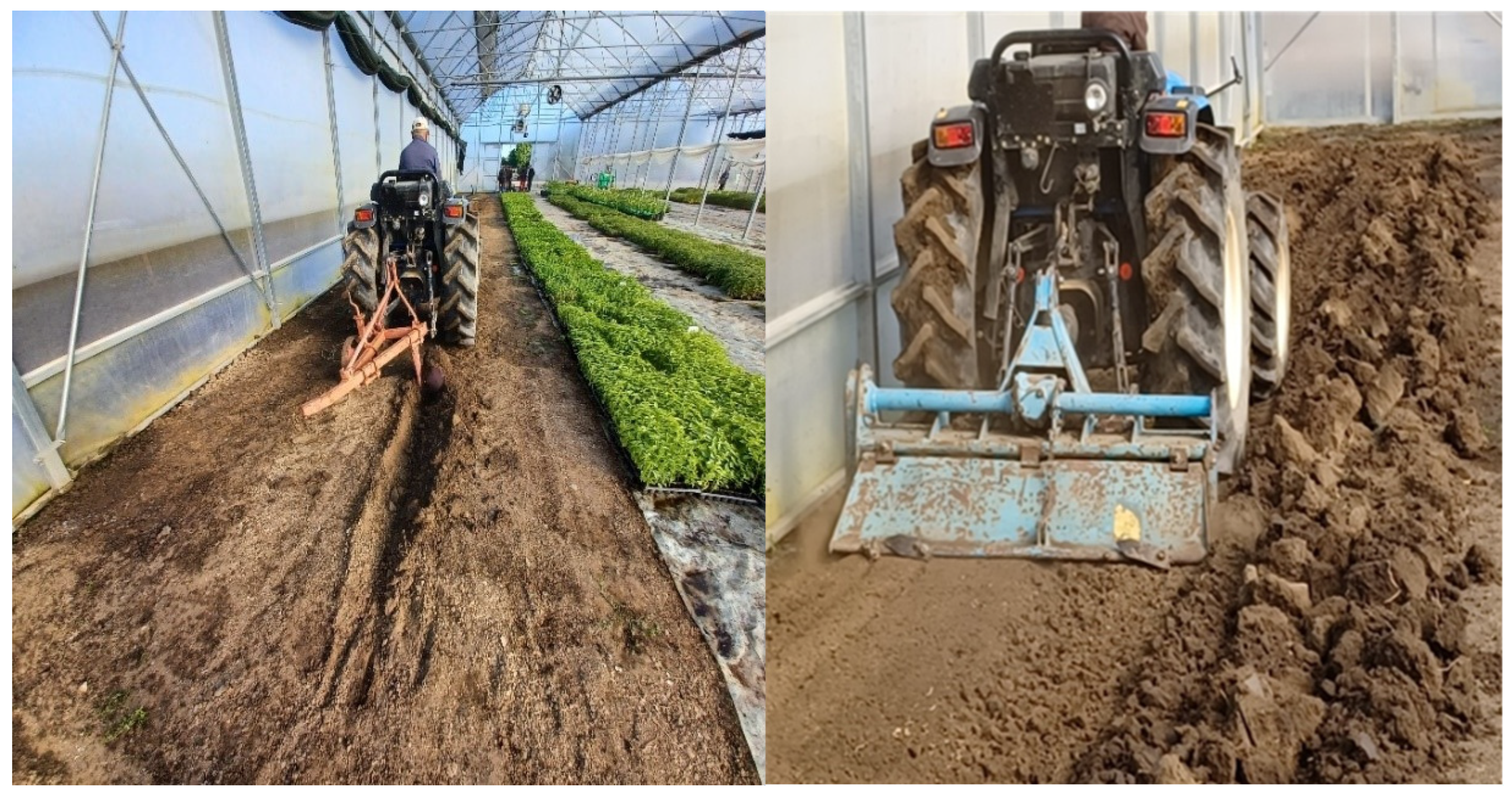
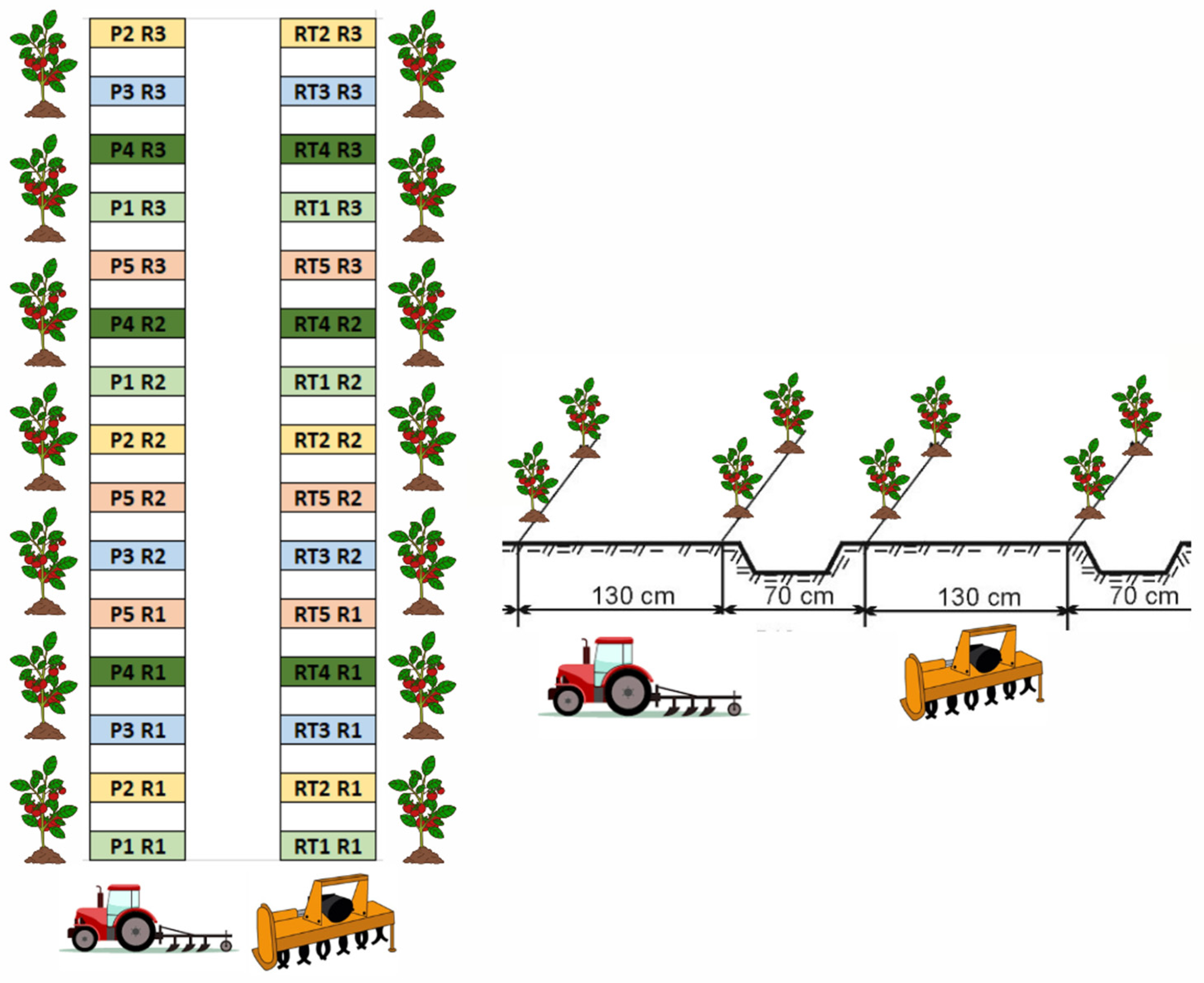
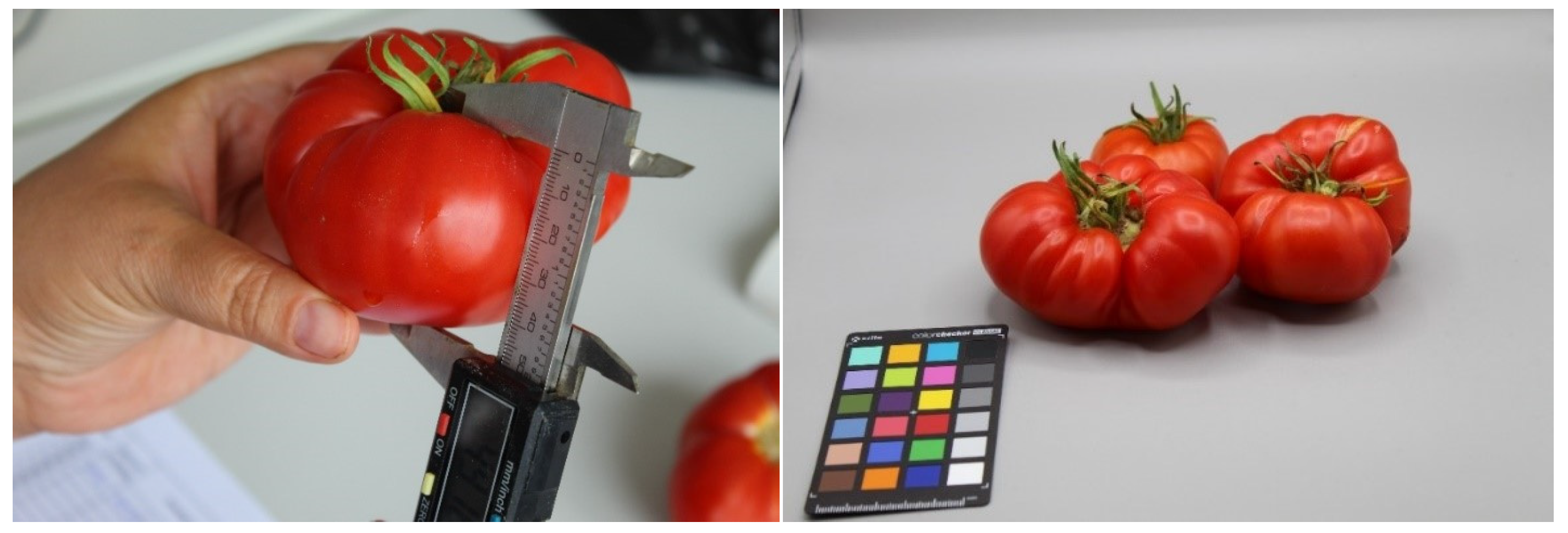
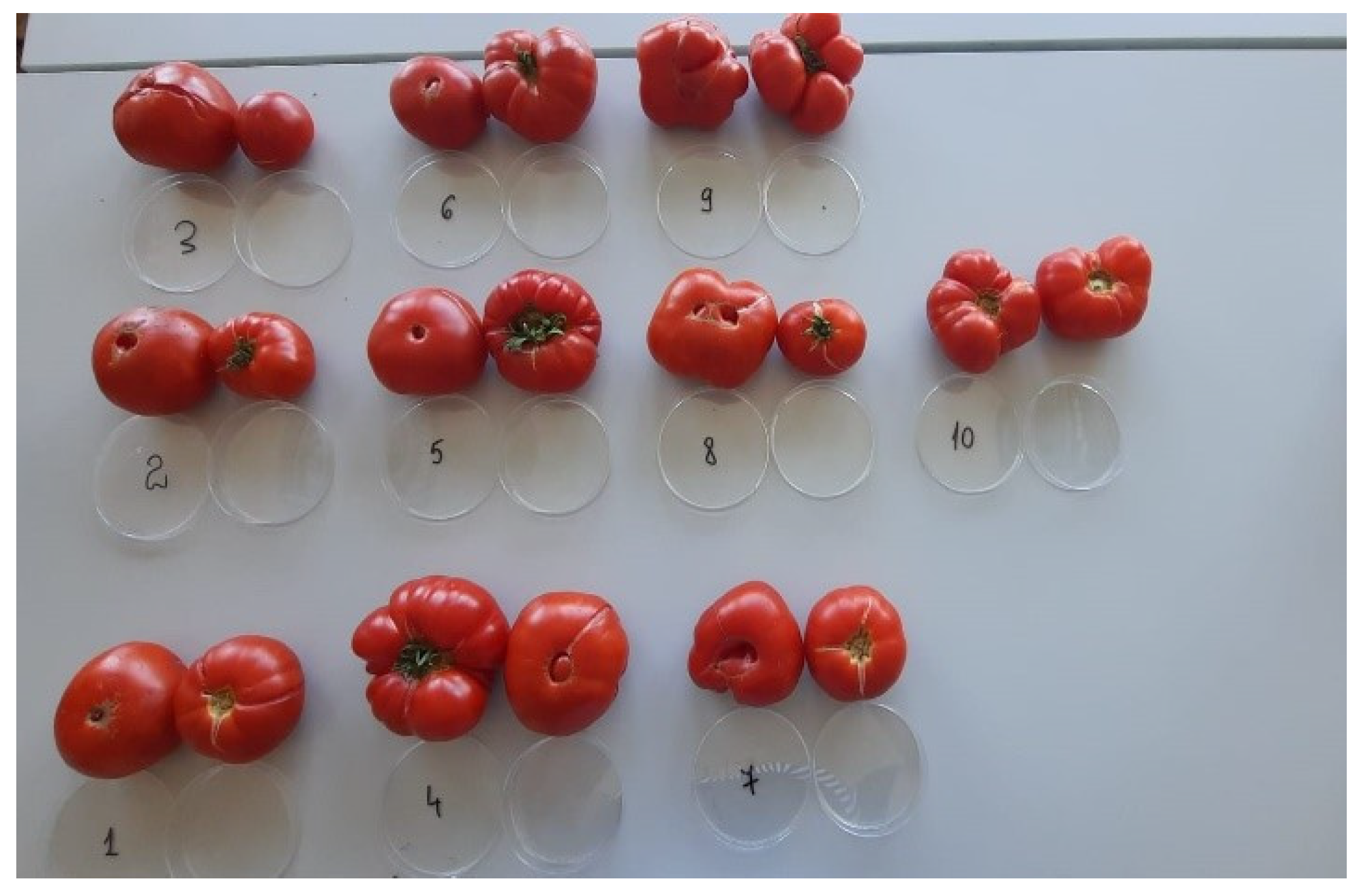
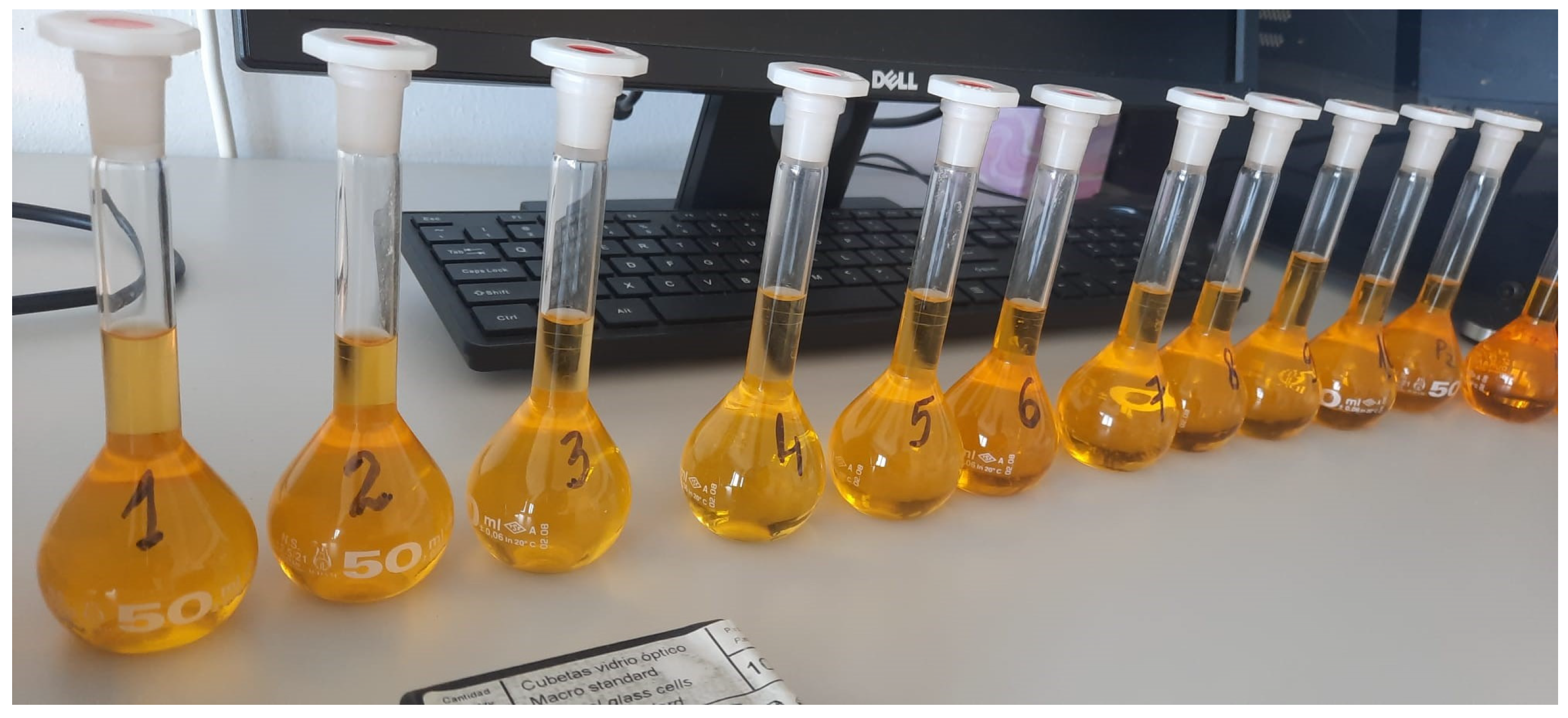

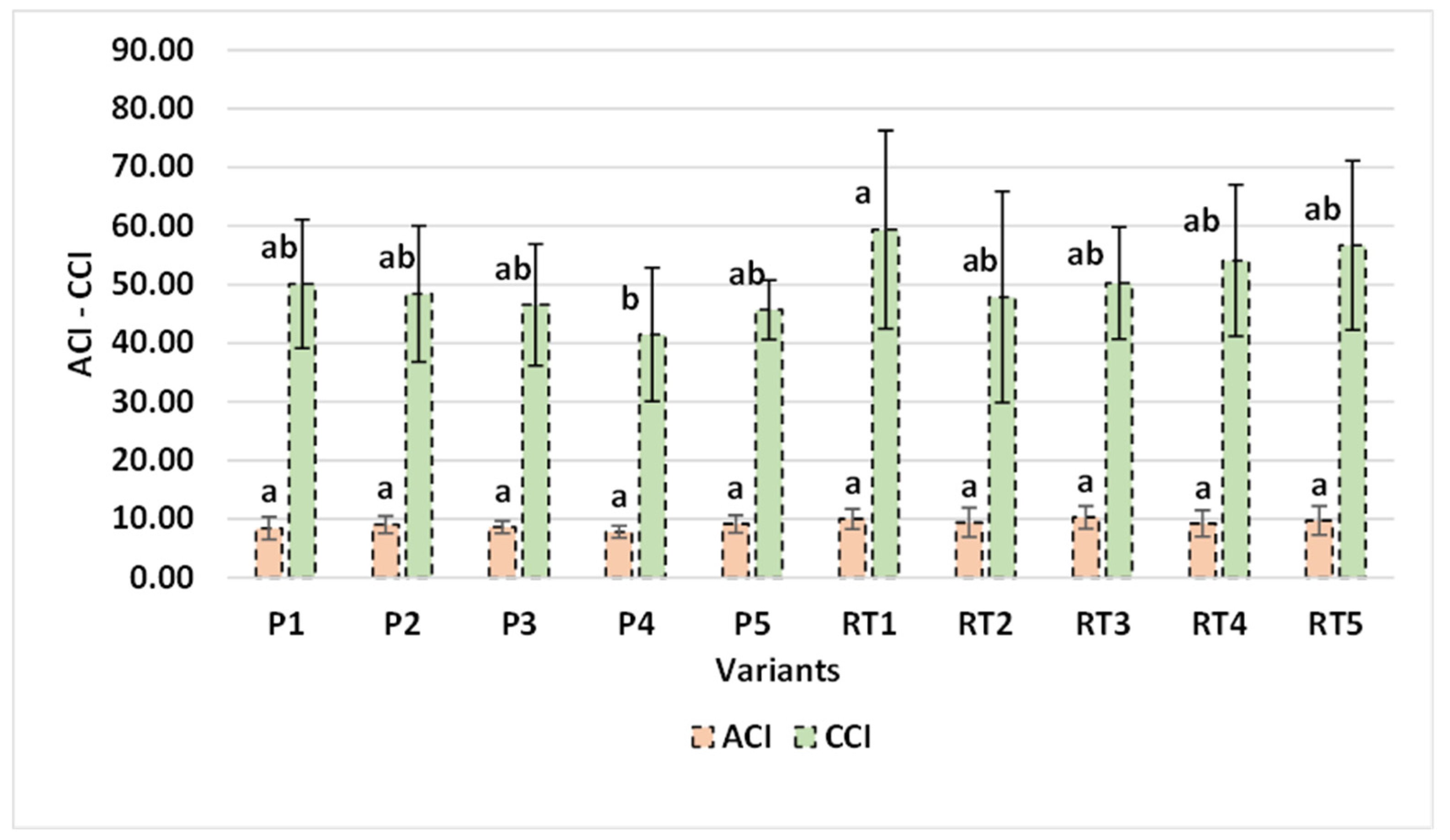
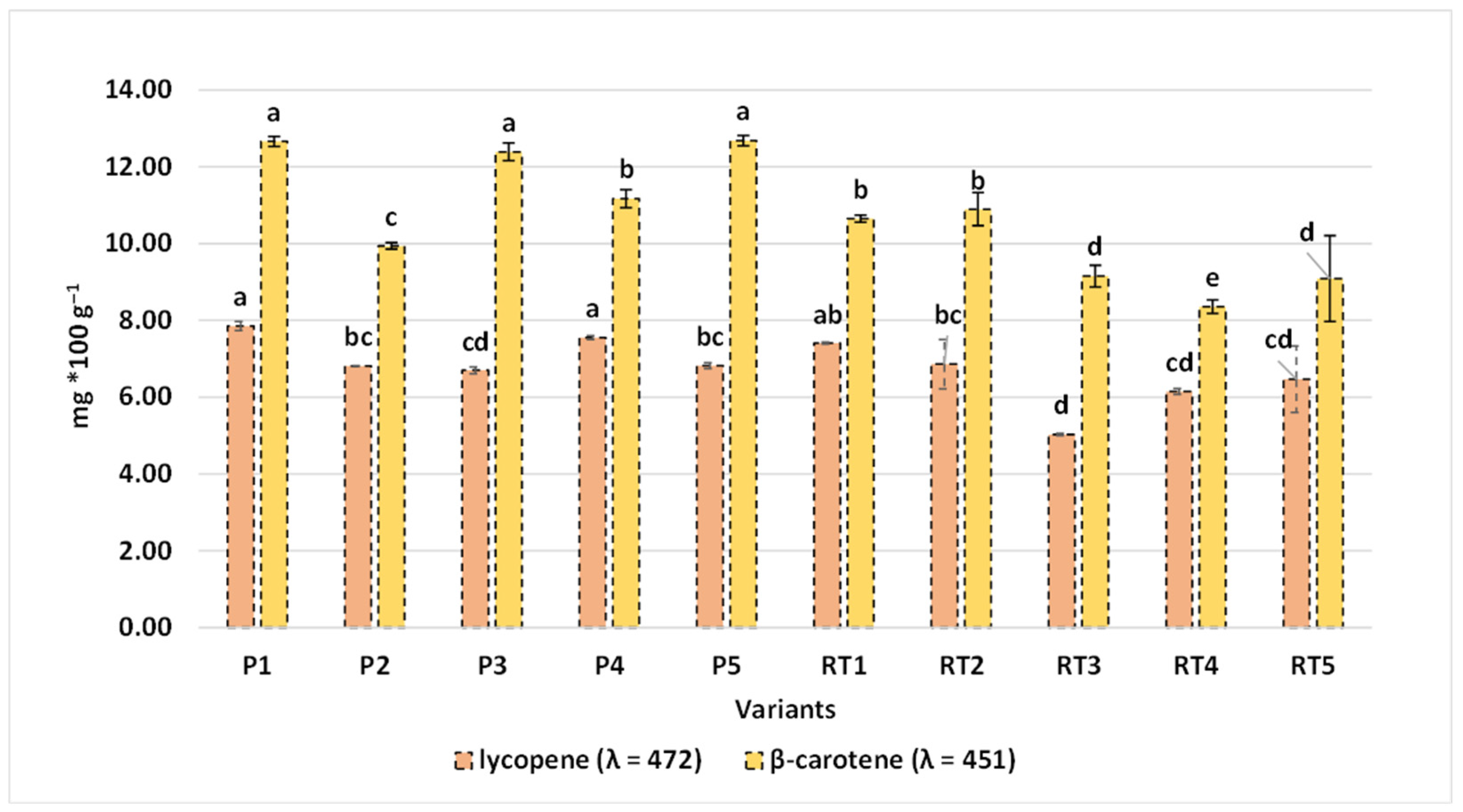
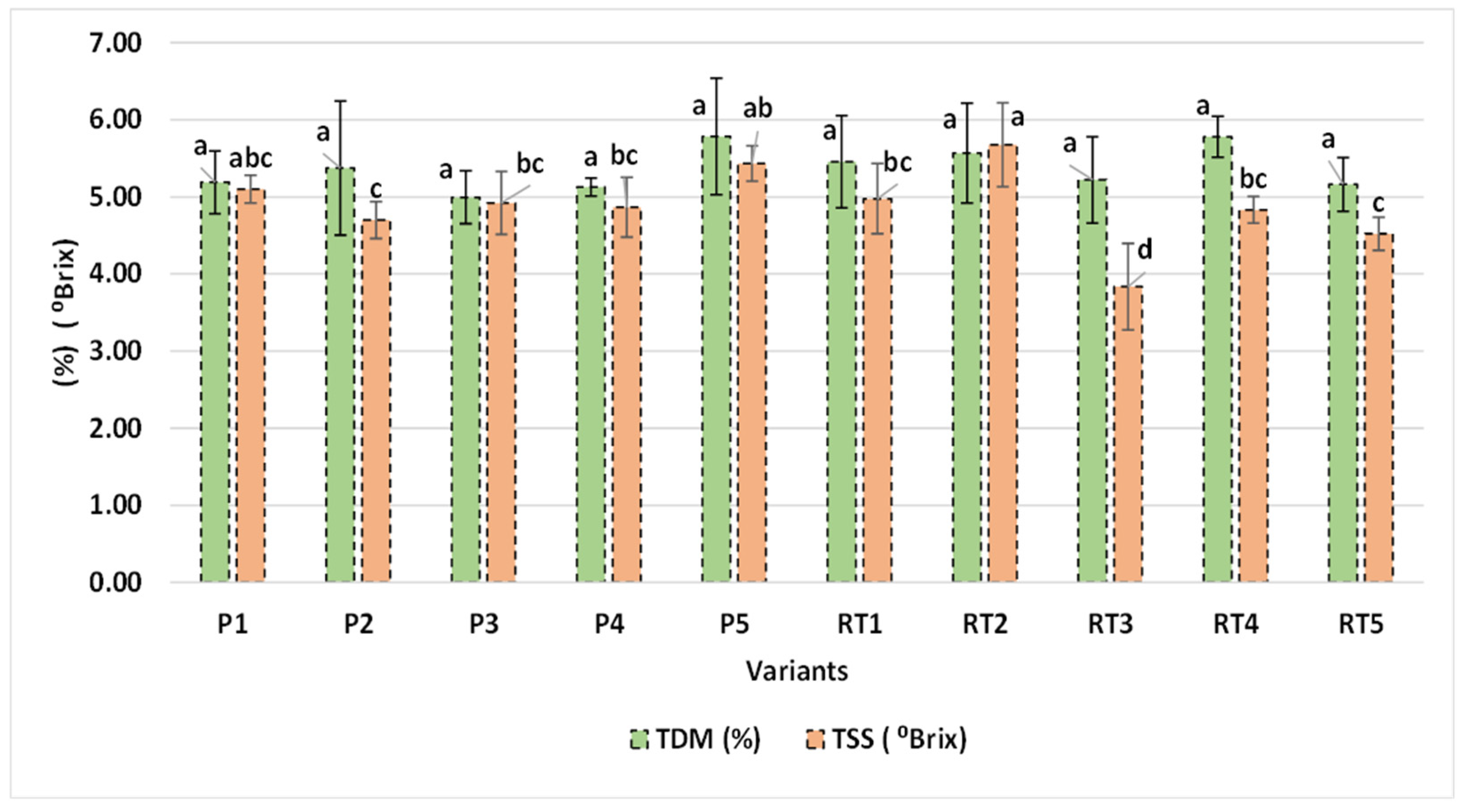
| Variant | Composition Profile | Manufacturer/Origin Details |
|---|---|---|
| (P;RT)1 | Albit—a poly-beta-hydroxybutyric acid (natural biopolymer derived from beneficial soil bacteria: Bacillus megaterium and Pseudomonas aureofaciens—0.62%), along with the following nutrients: total N2—7.5%; P2O5—6%; K2O—4.5%; MgO—0.6%; SO42−—2.7%; Turboroot—a comprehensive rooting and growth stimulator, containing: total humic extract—7.2% w/w; humic acids—5.76% (w/w), fulvic acids—1.44% (w/w), free L-alpha amino acids—3.54%, total N2—2.8 (w/w), P2O5—3.05% (w/w), K2O—4.46% (w/w) and chelated micronutrients: EDDHA (Fe)—0.017% (w/w); EDTA (Mn)—0.10% (w/w); EDTA (Zn)—0.05% (w/w); water-soluble Mo—0.05% (w/w); pH range of the chelated fraction—4–9. | Vitana/Albit—Russian Federation Ecoplant/Trade Corporation International—Spain |
| (P;RT)2 | Biochar—Apparent density < 3 mm—276 kg/m3; specific surface area (BET)—557.76 m2/g; ash content (at 550 degrees)—4.1% (w/w); organic carbon (C)—91.3% (w/w); total N2—0.66% (w/w); K—0.25% (w/w); Na—0.02% (w/w); Ca—1.1% (w/w); Fe—0.09% (w/w); Mg—0.05% (w/w); Mn—0.04% (w/w); S—0.03% (w/w); water retention capacity—162.5%; moisture content—6%; pH value—8.76 (CaCl2); EPA-PAH (below LOQ)—6 mg/kg. Wood Vinegar—A byproduct of biomass carbonization through pyrolysis, containing acetic acid and pyroligneous acid. It exhibits the following characteristics: organic carbon (C)—14 g/L; Kjeldahl nitrogen—3.37 mg/dm3; K—<20 mg/dm3; B—<2 mg/dm3; Cu—<0.4 mg/dm3; Fe—533 mg/dm3; P—<0.4 mg/dm3; Mg—0.809 mg/dm3; Mn—3.42 mg/dm3; pH value—4.24; NO2−—<5 mg/dm3; NO3−—<5 mg/dm3. Cropmax—A concentrated foliar fertilizer with the following characteristics: pH level of 7; N—0.2%; P2O5—0.4%; K2O—0.02%; Fe—220 mg/L; Mg—550 mg/L and Ca—10 mg/L. | Gekka Biochar/Explocom GK SRL—Romania Gekka Biochar/Explocom GK SRL—Romania Holland Farming B.V.—The Netherlands |
| (P;RT)3 | Nutriplant—A solid foliar fertilizer containing primary macronutrients and micronutrients: N2—20%; P2O5—20%; K2O—20%; B—0.02%; Cu—0.05%; Fe—0.01%; Mn—0.01%; Mo—0.02%; Zn—0.1%. Resid—Mycorrhizal fungus Glomus iranicum var. tenuihypharum var. nov.—1.2 × 104 | Green Has Group—Italy Symbor Business Development S.L—Spain |
| (P;RT)4 | Orgevit—An excellent source of nutrients and humus, presented in granular form, is entirely derived from natural origins, specifically avian sources; it contains all the essential micro and macronutrients, including: N2—4%; P2O5—2.5%; K2O—2.3%; Ca—9.3%; MgO—1.1% and organic substances—65%. Kerafol—A foliar fertilizer enriched with essential amino acids and a complex of hydrolyzed proteins and activators that enhance plant growth. Total amino acids: 28.00%; N2—4.30%; K2O—3.10%; organic carbon (C)—14.00% | MeMon B.V.—The Netherlands Altinco SL—Spain |
| (P;RT)5 | - |
| Variant | Plant Height (cm) | Number of Secondary Stems per Plant | Collar Stem Diameter (mm) | Number of Flowers per Plant |
|---|---|---|---|---|
| P | 50.55 ± 6.55 | 8.98 ± 1.36 | 11.88 ± 0.72 | 13.35 ± 2.75 |
| RT | 51.19 ± 5.96 | 8.15 ± 0.97 | 10.88 ± 1.20 | 12.23 ± 1.42 |
| ns | ns | ** | ns | |
| A×T | 54.60 ± 7.43 a | 8.45 ± 1.00 a | 11.53 ± 1.29 a | 12.22 ± 1.77 a |
| B×W×C | 43.72 ± 4.83 b | 8.06 ± 1.39 a | 11.05 ± 0.71 a | 11.68 ± 1.41 a |
| N×R | 53.10 ± 5.32 a | 9.50 ± 1.36 a | 11.28 ± 0.87 a | 14.33 ± 3.25 a |
| O×K | 50.10 ± 4.19 a | 8.62 ± 0.85 a | 11.53 ± 1.22 a | 12.73 ± 1.68 a |
| U | 52.83 ± 2.61 a | 8.22 ± 1.07 a | 11.50 ± 1.55 a | 13.00 ± 2.35 a |
| Variant | Plant Height (cm) | Number of Secondary Stems per Plant | Collar Stem Diameter (mm) | Number of Flowers per Plant |
|---|---|---|---|---|
| P1 | 50.67 ± 9.25 abc | 9.11 ± 1.36 ab | 12.66 ± 1.07 a | 12.53 ± 3.54 b |
| P2 | 43.22 ± 5.56 c | 8.22 ± 2.28 b | 11.38 ± 1.36 ab | 11.56 ± 3.43 b |
| P3 | 55.44 ± 7.5 a | 10.44 ± 1.51 a | 11.9 ± 0.84 ab | 16.44 ± 4.77 a |
| P4 | 50.11 ± 6.05 abc | 9 ± 1.41 ab | 11.71 ± 1.21 ab | 13.89 ± 2.89 ab |
| P5 | 53.33 ± 4.92 ab | 8.11 ± 2.26 b | 11.8 ± 1.21 ab | 12.33 ± 4.09 b |
| RT1 | 58.56 ± 4.1 a | 7.78 ± 1.39 b | 10.41 ± 1.63 b | 11.89 ± 2.47 b |
| RT2 | 44.22 ± 6.3 bc | 7.89 ± 1.76 b | 10.73 ± 1.1 ab | 11.78 ± 2.64 b |
| RT3 | 50.78 ± 6.08 abc | 8.56 ± 1.74 ab | 10.61 ± 1.36 ab | 12.23 ± 1.92 b |
| RT4 | 50.11 ± 7.37 abc | 8.22 ± 2.05 b | 11.35 ± 1.88 ab | 11.56 ± 1.94 b |
| RT5 | 52.33 ± 4.47 abc | 8.33 ± 1.66 b | 11.26 ± 2.36 ab | 13.67 ± 1.96 ab |
| Variant | ACI | CCI |
|---|---|---|
| P | 8.62 ± 0.93 | 46.45 ± 6.24 |
| RT | 9.73 ± 1.39 | 53.65 ± 2.42 |
| * | * | |
| Variant | ACI | CCI |
| A×T | 9.21 ± 1.56 a | 54.75 ± 10.68 a |
| B×W×C | 9.23 ± 1.47 a | 48.15 ± 9.03 a |
| N×R | 9.44 ± 1.54 a | 48.39 ± 6.18 a |
| O×K | 8.56 ± 1.11 a | 47.80 ± 9.25 a |
| U | 9.43 ± 0.96 a | 51.18 ± 8.43 a |
| Variant | Average Fruit Weight (g) | Fruit Width (mm) | Fruit Height (mm) | Fruit Form Index (Height/Width) | Number of Fruits per Plant | Total Yield per Plant (g) |
|---|---|---|---|---|---|---|
| P | 207.27 ± 24.68 | 78.51 ± 6.01 | 48.18 ± 2.43 | 0.62 ± 0.06 | 27.13 ± 4.22 | 5697.15 ± 1408.02 |
| RT | 228.87 ± 36.67 | 77.85 ± 7.73 | 48.39 ± 3.03 | 0.63 ± 0.07 | 25.87 ± 5.00 | 5836.81 ± 1109.30 |
| ns | ns | ns | ns | ns | ns | |
| A×T | 222.57 ± 26.52 ab | 74.75 ± 8.37 a | 48.56 ± 1.83 a | 0.66 ± 0.08 a | 28.00 ± 3.99 ab | 6208.38 ± 1025.02 ab |
| B×W×C | 234.62 ± 43.32 a | 75.22 ± 5.05 a | 48.13 ± 4.92 a | 0.64 ± 0.06 a | 23.00 ± 3.22 b | 5382.66 ± 1201.88 ab |
| N×R | 211.95 ± 18.60 ab | 79.07 ± 2.65 a | 48.94 ± 1.69 a | 0.62 ± 0.03 a | 26.17 ± 3.09 ab | 5592.39 ± 1126.24 ab |
| O×K | 229.35 ± 28.87 ab | 82.20 ± 9.47 a | 48.83 ± 1.97 a | 0.60 ± 0.07 a | 28.83 ± 3.30 a | 6619.89 ± 1185.17 a |
| U | 191.88 ± 32.23 b | 79.68 ± 5.42 a | 46.96 ± 3.25 a | 0.59 ± 0.06 a | 26.50 ± 7.17 ab | 5031.58 ± 1374.08 b |
| Variant | Average Fruit Weight (g) | Fruit Width (mm) | Fruit Height (mm) | Fruit Form Index (Height/Width) | Number of Fruits per Plant | Total Yield per Plant (g) |
|---|---|---|---|---|---|---|
| P1 | 203.28 ± 36.57 b | 79.75 ± 5.6 ab | 48.35 ± 2.66 a | 0.61 ± 0.03 ab | 30.33 ± 7.02 a | 6166.03 ± 773.51 a |
| P2 | 202.78 ± 29.54 b | 74.12 ± 15.83 ab | 49.72 ± 6.33 a | 0.67 ± 0.08 ab | 24.67 ± 21.59 ab | 5001.82 ± 1321.65 a |
| P3 | 205.54 ± 37.35 b | 78.8 ± 7 ab | 47.92 ± 2.36 a | 0.61 ± 0.03 ab | 25.67 ± 13.2 ab | 5275.5 ± 1164.7 a |
| P4 | 229.54 ± 49.81 ab | 80.94 ± 13.73 ab | 47.17 ± 1.66 a | 0.59 ± 0.09 ab | 30.33 ± 7.09 a | 6962.61 ± 1502.87 a |
| P5 | 195.34 ± 37.16 b | 78.95 ± 4.38 ab | 47.75 ± 5.24 a | 0.61 ± 0.06 ab | 24.67 ± 5.13 ab | 4818.44 ± 1815.42 a |
| RT1 | 241.88 ± 43.11 ab | 69.73 ± 8.96 b | 48.76 ± 4.97 a | 0.70 ± 0.08 a | 25.67 ± 14.43 ab | 6208.22 ± 1428.1 a |
| RT2 | 266.47 ± 48.85 a | 76.31 ± 8.51 ab | 46.53 ± 5.32 a | 0.61 ± 0.02 ab | 21.33 ± 3.21 b | 5684.65 ± 1239.38 a |
| RT3 | 218.37 ± 42.87 ab | 79.33 ± 6.46 ab | 49.98 ± 3.22 a | 0.63 ± 0.02 ab | 26.67 ± 5.03 ab | 5823.14 ± 1259.97 a |
| RT4 | 229.19 ± 64.04 ab | 83.45 ± 9.73 a | 50.49 ± 3.22 a | 0.61 ± 0.06 ab | 27.33 ± 5.51 ab | 6264.47 ± 899.07 a |
| RT5 | 188.46 ± 42.99 b | 80.42 ± 8.81 ab | 46.17 ± 3.35 a | 0.58 ± 0.07 b | 28.33 ± 3.51 ab | 5339.79 ± 1180.91 a |
| Variant | Lycopene (mg ×100 g−1 Fresh Weight) | Carotene (mg ×100 g−1 Fresh Weight) |
|---|---|---|
| P | 7.14 ± 0.49 | 11.77 ± 1.12 |
| RT | 6.38 ± 0.92 | 9.63 ± 1.12 |
| * | ** | |
| A×T | 7.63 ± 0.25 a | 11.66 ± 1.11 a |
| B×W×C | 6.84± 0.41 b | 10.42 ± 0.59 a |
| N×R | 5.85 ± 0.90 c | 10.77 ± 1.79 a |
| O×K | 6.85 ± 0.77 b | 9.76 ± 1.55 a |
| U | 6.65 ± 0.58 b | 10.88 ± 2.09 a |
| Variant | Dry Matter (%) | Soluble Solid Content (°Bx) |
|---|---|---|
| P | 5.29 ± 0.56 | 5.00 ± 0.35 |
| RT | 5.44 ± 0.49 | 4.77 ± 0.71 |
| ns | ns | |
| A×T | 5.32 ± 0.48 a | 5.04 ± 0.34 ab |
| B×W×C | 5.47 ± 0.69 a | 5.19 ± 0.67 a |
| N×R | 5.11 ± 0.43 a | 4.38 ± 0.69 b |
| O×K | 5.45 ± 0.40 a | 4.85 ± 0.28 ab |
| U | 5.47 ± 0.63 a | 4.98 ± 0.52 ab |
| Variant | Disease and Pest Management | |||
|---|---|---|---|---|
| Disease | Attack Severity (%) | Pest | Attack Severity % | |
| P1 | Tomato spotted wilt virus | 8.3% | - | - |
| Late blight (Phytophthora infestans) | 2% | |||
| P2 | Late blight (Phytophthora infestans) | 17% | Thrips tabaci | 16% |
| Tobacco mosaic virus | 6.7% | |||
| P3 | Bacterial spot (Xanthomonas campestris pv. vesicatoria) | 16% | Thrips tabaci | 16% |
| Tomato spotted wilt virus | 16% | Tetranichus urticae | 16% | |
| Tobacco mosaic virus | 32% | |||
| P4 | Tomato spotted wilt virus | 16% | Tetranichus urticae | 30% |
| Late blight (Phytophthora infestans) | 11% | |||
| P5 | Late blight (Phytophthora infestans) | 17% | Thrips tabaci | 16% |
| Tobacco mosaic virus | 6% | |||
| Bacterial spot (Xanthomonas campestris pv. vesicatora) | 1.6% | |||
| RT1 | Tomato spotted wilt virus | 13.3% | - | - |
| Bacterial spot (Xanthomonas campestris pv. vesicatora) | 1.6% | |||
| Late blight (Phytophthora infestans) | 6.7% | |||
| RT2 | Bacterial spot (Xanthomonas campestris pv. vesicatora) | 1.3% | Tetranichus urticae | 23% |
| RT3 | Tomato spotted wilt virus | 2.3% | Thrips tabaci | 30% |
| Tobacco mosaic virus | 3% | |||
| RT4 | Bacterial spot (Xanthomonas campestris pv. vesicatora) | 16% | Thrips tabaci | 16% |
| Tobacco mosaic virus | 10% | Tetranichus urticae | 50% | |
| RT5 | Late blight (Phytophthora infestans) | 40% | Tetranichus urticae | 25% |
| Tobacco mosaic virus | 23% | |||
| Analyzed Variants (Mean Sample) | Visual Assessment Score | Observations | Significance |
|---|---|---|---|
| P Variants | 3–4 | Aggregates measuring approximately 12 cm, characterized by the presence of macropores and fissures. | A well-structured matrix conducive to enhanced air and water movement; macropores facilitate rapid drainage and aeration, essential for root respiration and microbial activity, while the fissures contribute to root penetration and expansion, supporting plant stability and nutrient acquisition; the structural composition suggests an advanced degree of aggregation likely favorable for soil health, susceptibility to compaction but and enhanced overall ecosystem resilience. |
| RT Variants | 2–3 | A mixture of aggregates exhibiting varying degrees of porosity, rounded and granular, approximately 5 cm in size, with roots distributed throughout the entire sample. | An aerated soil matrix capable of facilitating root penetration and distribution, likely enhancing water retention and promoting efficient nutrient exchange; the presence of well-dispersed roots throughout the sample implies favorable conditions for root anchorage and resource absorption, indicative of a supportive environment for plant growth; this aggregate diversity also contributes to soil stability, potentially mitigating erosion and promoting sustainable soil health in agricultural applications. |
Disclaimer/Publisher’s Note: The statements, opinions and data contained in all publications are solely those of the individual author(s) and contributor(s) and not of MDPI and/or the editor(s). MDPI and/or the editor(s) disclaim responsibility for any injury to people or property resulting from any ideas, methods, instructions or products referred to in the content. |
© 2025 by the authors. Licensee MDPI, Basel, Switzerland. This article is an open access article distributed under the terms and conditions of the Creative Commons Attribution (CC BY) license (https://creativecommons.org/licenses/by/4.0/).
Share and Cite
Avasiloaiei, D.I.; Calara, M.; Brezeanu, P.M.; Bălăiță, C.; Brumă, I.S.; Brezeanu, C. Optimizing Tomato Yield and Quality in Greenhouse Cultivation Through Fertilization and Soil Management. Agronomy 2025, 15, 2045. https://doi.org/10.3390/agronomy15092045
Avasiloaiei DI, Calara M, Brezeanu PM, Bălăiță C, Brumă IS, Brezeanu C. Optimizing Tomato Yield and Quality in Greenhouse Cultivation Through Fertilization and Soil Management. Agronomy. 2025; 15(9):2045. https://doi.org/10.3390/agronomy15092045
Chicago/Turabian StyleAvasiloaiei, Dan Ioan, Mariana Calara, Petre Marian Brezeanu, Claudia Bălăiță, Ioan Sebastian Brumă, and Creola Brezeanu. 2025. "Optimizing Tomato Yield and Quality in Greenhouse Cultivation Through Fertilization and Soil Management" Agronomy 15, no. 9: 2045. https://doi.org/10.3390/agronomy15092045
APA StyleAvasiloaiei, D. I., Calara, M., Brezeanu, P. M., Bălăiță, C., Brumă, I. S., & Brezeanu, C. (2025). Optimizing Tomato Yield and Quality in Greenhouse Cultivation Through Fertilization and Soil Management. Agronomy, 15(9), 2045. https://doi.org/10.3390/agronomy15092045








